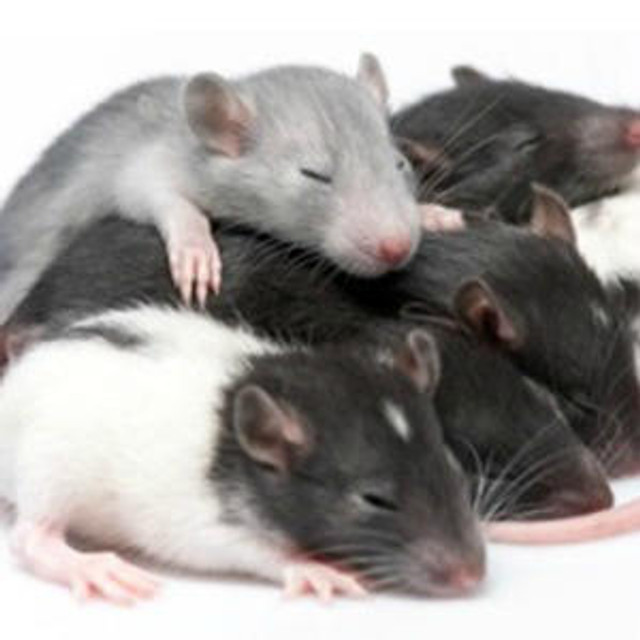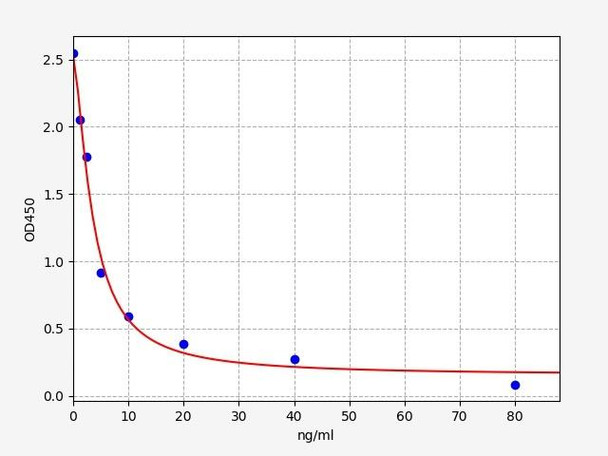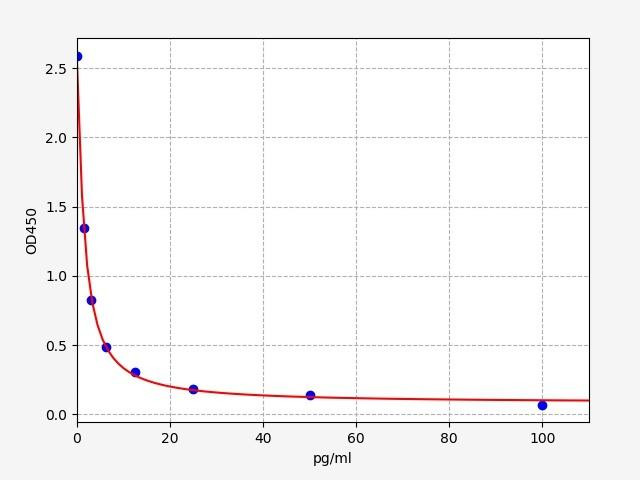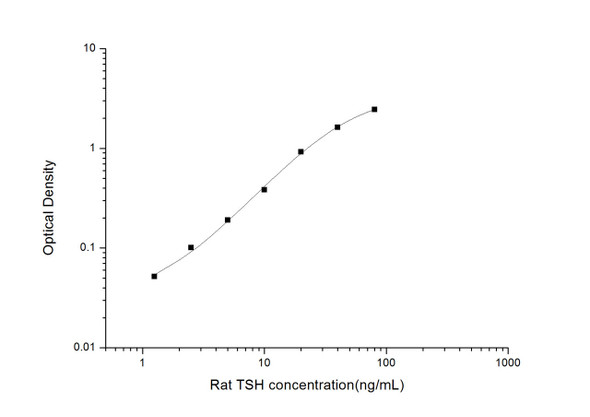The Rat TSH ELISA kit is designed for the quantitative measurement of rat Thyroid Stimulating Hormone (TSH) levels in various biological samples. TSH is a crucial hormone that regulates the thyroid gland's function and plays a pivotal role in maintaining metabolic balance. This kit enables researchers to accurately assess TSH concentrations in rat samples, aiding investigations into thyroid function, endocrine disorders, and related research areas.
Description
Rat TSH ELISA Kit
Key Features
| Save Time | Pre-coated 96 well plate | |
| Quick Start | Kit includes all necessary reagents | |
| Publication Ready | Reproducible and reliable results |
Overview
| Product Name: | Rat TSH (Thyroid Stimulating Hormone) ELISA Kit |
| Product Code: | RTFI01195 |
| Size: | 96 Assays |
| Alias: | TSH, Thyroid Stimulating Hormone |
| Detection Method: | Competitive ELISA, Coated with Antibody |
| Reactivity: | Rat |
| Sensitivity: | 0.75ng/ml |
| Range: | 1.25-80ng/ml |
| Storage: | 4°C for 6 months |
| Note: | For Research Use Only |
Additional Information
| Recovery | Matrices listed below were spiked with certain level of Mouse TSH and the recovery rates were calculated by comparing the measured value to the expected amount of Mouse TSH in samples.
| ||||||||||||||||||||
| Linearity: | The linearity of the kit was assayed by testing samples spiked with appropriate concentration of Mouse TSH and their serial dilutions. The results were demonstrated by the percentage of calculated concentration to the expected.
| ||||||||||||||||||||
| Intra Assay | CV < 8% | ||||||||||||||||||||
| Inter Assay | CV < 10% |
Kit Components
| Component | Quantity | Storage |
| ELISA Microplate (Dismountable) | 8x12 strips | 4°C for 6 months |
| Lyophilized Standard | 2 | 4°C/ -20°C |
| Sample/Standard Dlution Buffer | 20ml | 4°C |
| Biotin-labeled Antibody (Concentrated) | 120ul | 4°C (Protection from light) |
| Antibody Dilution Buffer | 10ml | 4°C |
| HRP-Streptavidin Conjugate (SABC) | 120ul | 4°C (Protect from light) |
| SABC Dilution Buffer | 10ml | 4°C |
| TMB Substrate | 10ml | 4°C (Protection from light) |
| Stop Solution | 10ml | 4°C |
| Wash Buffer (25X) | 30ml | 4°C |
| Plate Sealer | 5 | - |
Other materials required:
- Microplate reader with 450 nm wavelength filter
- Multichannel Pipette, Pipette, microcentrifuge tubes and disposable pipette tips
- Incubator
- Deionized or distilled water
- Absorbent paper
- Buffer resevoir
Protocol
*Note: Protocols are specific to each batch/lot. For the correct instructions please follow the protocol included in your kit.
Equilibrate the TMB substrate for at least 30 min at 37°C beforeuse. When diluting samples and reagents, they must be mixed completely andevenly. It is recommended to plot a standard curve for each test.
| Step | Procedure |
| 1. | Set standard, test sample and control (zero) wells on the pre-coatedplate respectively, and then, record their positions. It isrecommended to measure each standard and sample in duplicate. Washplate 2 times before adding standard, sample and control (zero) wells! |
| 2. | Add Sample and Biotin-detection antibody: Add 50µL of Standard, Blank or Sample per well. The blankwell is added with Sample Dilution Buffer. Immediately add 50 µL of biotin-labelled antibody workingsolution to each well. Cover with the plate sealer provided. Gently tap the plate to ensure thoroughmixing. Incubate for 45 minutes at 37°C. (Solutions are added to the bottom of micro-ELISA platewell, avoid touching plate walls and foaming). |
| 3. | Wash: Aspirate each well and wash, repeating the process three timesWash by filling each well with Wash Buffer (approximately 350µL)using a squirt bottle, multi-channel pipette, manifold dispenser orautomated washer. Complete removal of liquid at each step is essentialto good performance. After the last wash, remove any remaining WashBuffer by aspirating or decanting. Invert the plate and pat it againstthick clean absorbent paper. |
| 4. | HRP-Streptavidin Conjugate(SABC): Add 100µL of SABC workingsolution to each well. Cover with a new Plate sealer. Incubate for30minutes at 37°C. |
| 5. | Wash: Repeat the aspiration/wash process for five times. |
| 6. | TMB Substrate: Add 90µL of TMB Substrate to each well. Coverwith a new Plate sealer. Incubate for about 10-20 minutes at 37°C.Protect from light. The reaction time can be shortened or extendedaccording to the actual color change, but not more than 30minutes.When apparent gradient appeared in standard wells, you can terminatethe reaction. |
| 7. | Stop: Add 50µL of Stop Solution to each well. Color turn toyellow immediately. The adding order of stop solution should be as thesame as the substrate solution. |
| 8. | OD Measurement: Determine the optical density (OD Value) of each wellat once, using a microplate reader set to 450 nm. You should open themicroplate reader ahead, preheat the instrument, and set the testing parameters. |
Sample Type
When carrying out an ELISA assay it is important to prepare your samples in order to achieve the best possible results. Below we have a list of procedures for the preparation of samples for different sample types.
| Sample Type | Protocol |
| Serum | If using serum separator tubes, allow samples to clot for 30 minutes at room temperature. Centrifuge for 10 minutes at 1,000x g. Collect the serum fraction and assay promptly or aliquot and store the samples at -80°C. Avoid multiple freeze-thaw cycles. If serum separator tubes are not being used, allow samples to clot overnight at 2-8°C. Centrifuge for 10 minutes at 1,000x g. Remove serum and assay promptly or aliquot and store the samples at -80°C. Avoid multiple freeze-thaw cycles. |
| Plasma | Collect plasma using EDTA or heparin as an anticoagulant. Centrifuge samples at 4°C for 15 mins at 1000 × g within 30 mins of collection. Collect the plasma fraction and assay promptly or aliquot and store the samples at -80°C. Avoid multiple freeze-thaw cycles. Note: Over haemolysed samples are not suitable for use with this kit. |
| Urine & Cerebrospinal Fluid | Collect the urine (mid-stream) in a sterile container, centrifuge for 20 mins at 2000-3000 rpm. Remove supernatant and assay immediately. If any precipitation is detected, repeat the centrifugation step. A similar protocol can be used for cerebrospinal fluid. |
| Cell culture supernatant | Collect the cell culture media by pipette, followed by centrifugation at 4°C for 20 mins at 1500 rpm. Collect the clear supernatant and assay immediately. |
| Cell lysates | Solubilize cells in lysis buffer and allow to sit on ice for 30 minutes. Centrifuge tubes at 14,000 x g for 5 minutes to remove insoluble material. Aliquot the supernatant into a new tube and discard the remaining whole cell extract. Quantify total protein concentration using a total protein assay. Assay immediately or aliquot and store at ≤ -20 °C. |
| Tissue homogenates | The preparation of tissue homogenates will vary depending upon tissue type. Rinse tissue with 1X PBS to remove excess blood & homogenize in 20ml of 1X PBS (including protease inhibitors) and store overnight at ≤ -20°C. Two freeze-thaw cycles are required to break the cell membranes. To further disrupt the cell membranes you can sonicate the samples. Centrifuge homogenates for 5 mins at 5000xg. Remove the supernatant and assay immediately or aliquot and store at -20°C or -80°C. |
| Tissue lysates | Rinse tissue with PBS, cut into 1-2 mm pieces, and homogenize with a tissue homogenizer in PBS. Add an equal volume of RIPA buffer containing protease inhibitors and lyse tissues at room temperature for 30 minutes with gentle agitation. Centrifuge to remove debris. Quantify total protein concentration using a total protein assay. Assay immediately or aliquot and store at ≤ -20 °C |
| Breast Milk | Collect milk samples and centrifuge at 10,000 x g for 60 min at 4°C. Aliquot the supernatant and assay. For long term use, store samples at -80°C. Minimize freeze/thaw cycles. |
TSH Background
TSH Background
TSH, also referred to as thyroid-stimulating hormone, is a glycoprotein hormone created by the anterior pituitary. It serves as the thyroid gland's main stimulant for producing thyroid hormones. Additionally, it causes the thyroid's follicular cells to expand, which results in thyroid hypertrophy. TSH release is controlled by the hypothalamic-pituitary axis. Thyroid-releasing hormone, or TRH, is specifically released by neurons in the hypothalamus, stimulating the anterior pituitary's thyrotrophs to generate TSH.
TSH Levels
TSH is a hormone produced by the pituitary gland, and its primary function is to regulate the production and release of thyroid hormones (T3 and T4) from the thyroid gland. The normal range of TSH levels can vary slightly depending on the laboratory and the specific assay used. In general, the reference range for TSH levels is typically between 0.4 to 4.0 milli-international units per liter (mIU/L). However, it's essential to note that the reference range may vary based on the individual's age, sex, and specific health conditions.
TSH Structure and Function
TSH is composed of two subunits, an alpha subunit, and a beta subunit, with molecular weight of 28 kDa. The alpha subunit is common to several other hormones, including luteinizing hormone (LH), follicle-stimulating hormone (FSH), and human chorionic gonadotropin (hCG). The beta subunit is unique to TSH and is responsible for its specific actions on the thyroid gland.
TSH plays a key role in regulating the function of the thyroid gland, which is situated in the neck. Its primary function is to stimulate the thyroid gland to produce and release two other hormones, namely thyroxine (T4) and triiodothyronine (T3), into the bloodstream. These thyroid hormones are essential for maintaining the body's metabolism, energy levels, and overall growth and development.
Rat TSH ELISA Kit FAQs
Q: What is the purpose of the Rat TSH ELISA kit?
The Rat TSH ELISA kit is designed for the quantitative measurement of rat Thyroid Stimulating Hormone (TSH) levels in various biological samples. TSH is a crucial hormone that regulates the thyroid gland's function and plays a pivotal role in maintaining metabolic balance. This kit enables researchers to accurately assess TSH concentrations in rat samples, aiding investigations into thyroid function, endocrine disorders, and related research areas.
Q: Which types of samples can I analyze with this kit?
This kit is suitable for analyzing rat serum, plasma, and other bodily fluids. Detailed sample preparation guidelines can be found in the kit's user manual.
Q: Is this kit intended for diagnostic purposes?
The rat TSH ELISA kit is intended for research purposes only and should not be used for diagnostic applications. Research results should not be used as a basis for clinical decisions.
Q: Is the kit compatible with other species besides Rats?
This kit has been developed specifically for rat samples. While it may cross-react with TSH TSH species, it is recommended to consult the product manual or contact technical support for information regarding cross-reactivity.
Q: Where can I find additional technical support or assistance with the kit?
For any technical inquiries or assistance regarding the kit, you can reach out to our team. They will be available to answer your questions and provide the necessary guidance to ensure a successful experiment.
Related Products

| Rat T3 (Triiodothyronine) ELISA Kit | |
|---|---|
| ELISA Type: | Competitive |
| Sensitivity: | 0.094ng/ml |
| Range: | 0.156-10ng/ml |

| Rat Thyroglobulin (Tg) ELISA Kit | |
|---|---|
| ELISA Type: | Sandwich |
| Range: | 15.6-1000 pg/mL |
| Reactivity: | Rat |
Citations
| Sakr et al. | Zinc oxide nanoparticles induce oxidative stress and histopathological toxicity in the thyroid gland and liver of rats | Tox & Environ Chem. (2021) | View Citation |







